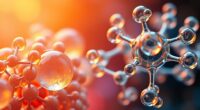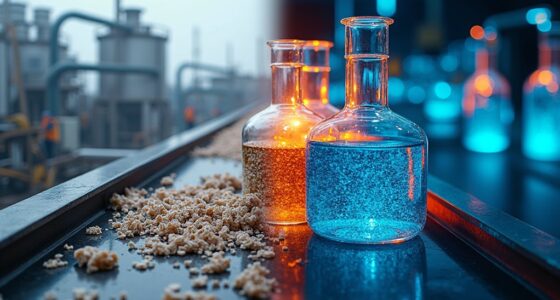Green chemistry makes industrial processes safer and cleaner. For example, BASF’s HPPO process produces propylene oxide with minimal waste, using a catalyst that only creates water as a byproduct. Bio-based manufacturing employs microorganisms to create biodegradable fibers and plastics from renewable sources. In pharmaceuticals, enzyme-driven reactions and continuous flow methods reduce waste and toxic chemicals. Waste prevention and energy-efficient techniques further enhance sustainability. Keep exploring to discover how these innovations are shaping a greener future.
Key Takeaways
- The HPPO process epoxidizes propylene with hydrogen peroxide, producing water as the only byproduct, reducing waste and hazards.
- Microbial fermentation converts plant sugars and waste into biodegradable plastics and bio-based fibers, promoting renewable resources.
- Using biocatalysts and green catalysts in pharmaceutical synthesis minimizes toxic reagents and enhances reaction selectivity.
- Designing syntheses with high atom economy and catalytic processes reduces waste generation and improves resource efficiency.
- Process intensification and flow chemistry techniques optimize energy use and lower environmental impact in chemical manufacturing.
Industrial Innovations: DOW and BASF’s HPPO Process

Have you ever wondered how industries are making chemical processes greener and more sustainable? The HPPO process, developed by BASF and Dow Chemical, does just that by epoxidizing propylene with hydrogen peroxide to produce propylene oxide.
It uses a titanium-silicalite catalyst in methanol, operating at moderate temperatures and pressures in a fixed-bed reactor. This method’s environmental benefits are significant—it produces only water as a byproduct, drastically reducing waste, energy, and water consumption compared to traditional methods. The process is also scalable, allowing for large production capacities that meet industrial demands. Additionally, its efficiency aligns with green chemistry principles, promoting safer and less wasteful manufacturing practices. With a capacity of up to 300,000 metric tons annually, the process offers economies of scale and lowers costs. Its smaller physical footprint and energy efficiency make it a more sustainable and competitive choice for manufacturing propylene oxide, essential for countless industrial applications.
Sustainable Bio-Based Manufacturing Methods
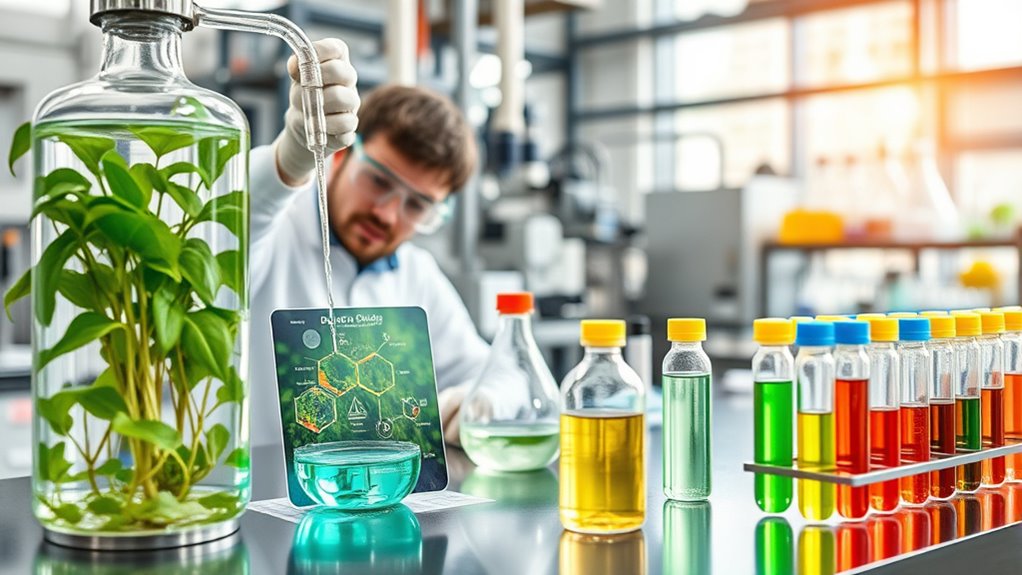
Sustainable bio-based manufacturing methods leverage biological processes and renewable resources to create eco-friendly materials. You can use microbial fermentation to produce bio-based fibers, like synthetic spider silk, which offers high strength and elasticity as a greener alternative to petroleum textiles. Biological process efficiency helps optimize resource use and minimize waste in manufacturing. Genetically engineered microorganisms ferment plant sugars to biosynthesize biodegradable nylon, reducing reliance on fossil fuels. Agricultural and food waste serve as feedstocks, converting residues into recyclable plastics such as polylactic acid (PLA) and cellulose-based fibers. These processes maximize biomass utilization, minimizing waste. Additionally, fungal mycelium can be used in furniture and packaging, providing renewable, compostable options. Incorporating renewable energy sources further reduces emissions and enhances the sustainability of these bio-based processes. By integrating renewable energy sources and green chemistry principles, these methods markedly lower carbon footprints, enhance resource efficiency, and promote circular economy practices in manufacturing.
Greener Approaches in Pharmaceutical Production
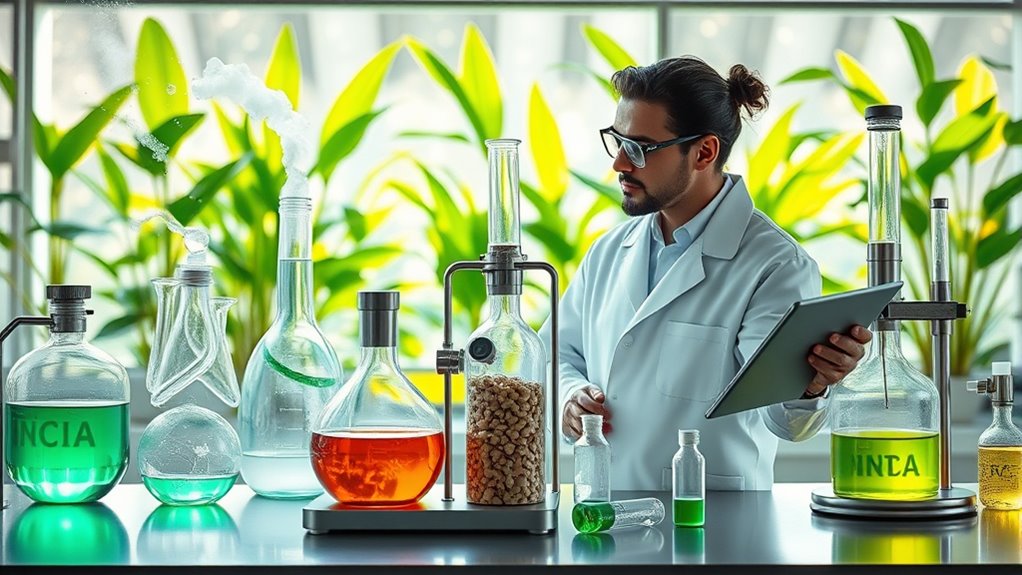
Greener approaches in pharmaceutical production focus on minimizing environmental impact through innovative synthetic routes and advanced catalysis techniques. You can reduce waste by adopting renewable feedstocks and environmentally friendly methods. Using biocatalysts or enzymes makes chemical transformations more selective and less wasteful, while advances in enzyme catalysis improve efficiency and cut hazardous reagents. Implementing green catalysts can further enhance process sustainability and reduce reliance on toxic materials. Continuous flow synthesis helps control reactions better, decreasing starting material waste and unwanted byproducts. Additionally, reducing or eliminating precious metal catalysts like palladium and platinum lowers toxicity and conserves resources. Green chromatography and spectroscopy techniques minimize hazardous reagent use during quality control, and real-time analytical methods optimize processes, further cutting waste and energy use. These strategies collectively support more sustainable, safer pharmaceutical manufacturing.
Waste Prevention and Atom Economy Strategies
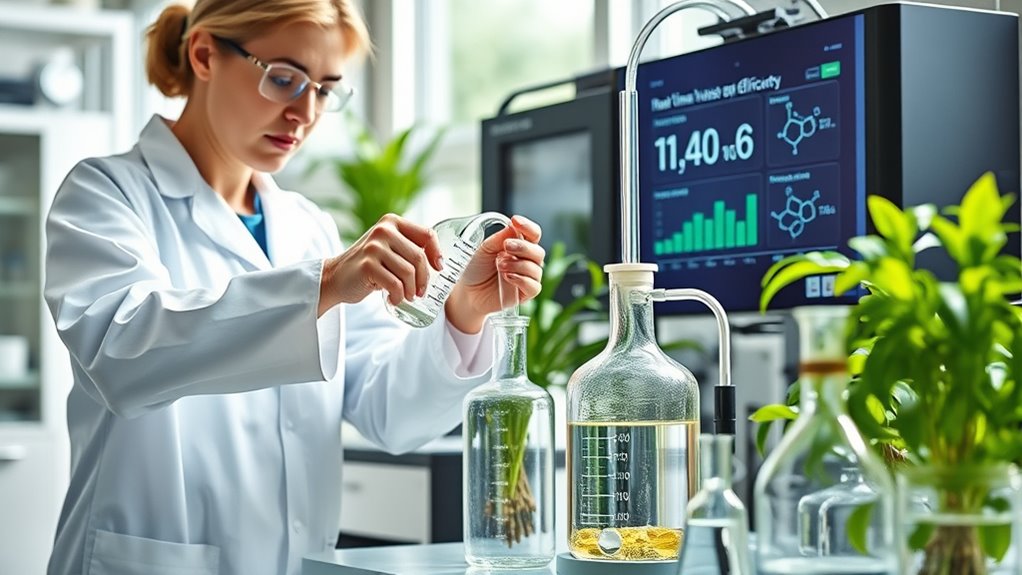
Implementing waste prevention and atom economy strategies is essential for making chemical processes more environmentally friendly. You can design syntheses that prevent waste before it forms, reducing cleanup needs. Using recycling, composting, and renewable feedstocks helps minimize resource depletion and waste output. Monitoring reactions in real time allows you to detect and limit byproducts early, avoiding unnecessary waste. Favor catalytic processes over stoichiometric reagents, as catalysts are reusable and generate fewer by-products. Maximize atom economy by choosing routes that incorporate most reactant atoms into the final product, minimizing waste atoms. Select reaction pathways that reduce by-product formation and avoid auxiliary reagents and solvents that don’t contribute to the final product. The First Principle emphasizes that waste should be prevented rather than treated or disposed of after formation. Incorporating artistic and cultural considerations into process design can enhance stakeholder acceptance and promote sustainable practices. These strategies collectively promote cleaner, more sustainable chemical manufacturing.
Enhancing Energy Efficiency in Chemical Processes
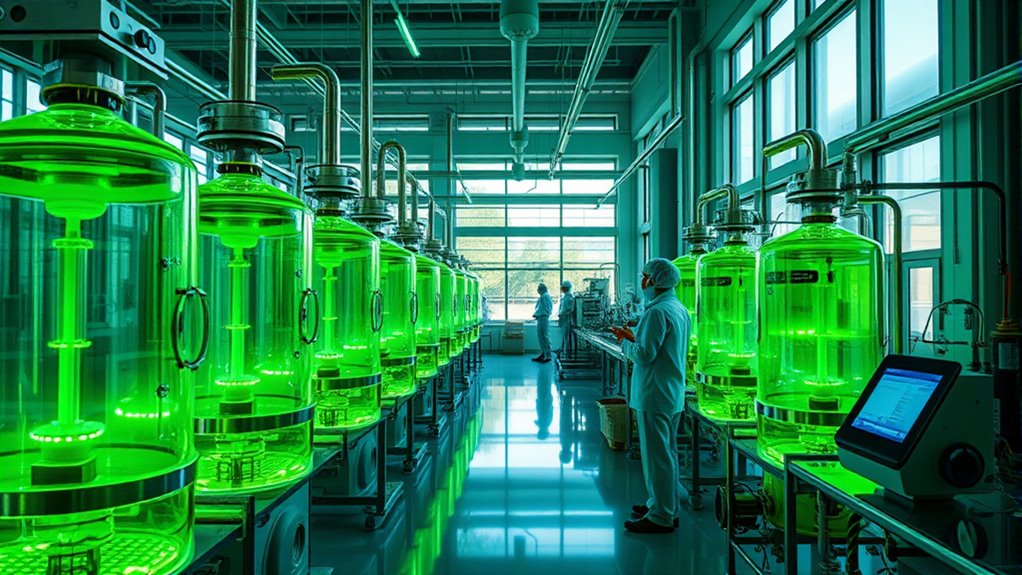
Enhancing energy efficiency in chemical processes involves adopting innovative techniques that optimize the use of thermal and electrical energy. Process intensification combines multiple reaction and separation steps into fewer units, saving up to 80% of energy in some cases, and boosts productivity through better heat and mass transfer. Incorporating renewable energy sources, such as solar or wind power, can further reduce the carbon footprint of chemical manufacturing. Renewable energy integration Microreactors and flow chemistry help fine-tune reaction conditions, reducing energy consumption. Heat integration captures waste heat from exothermic reactions and recycles it for endothermic steps, cutting reliance on external energy sources. Advanced process control, like model predictive control and real-time monitoring, fine-tunes temperatures and pressures to minimize waste. Energy-efficient technologies Continuous flow processing maintains steady conditions, lowering start-up costs and energy losses. Together, these strategies drastically improve efficiency, cut costs, and make your process more sustainable.
Future Trends and Industry Adoption of Green Chemistry
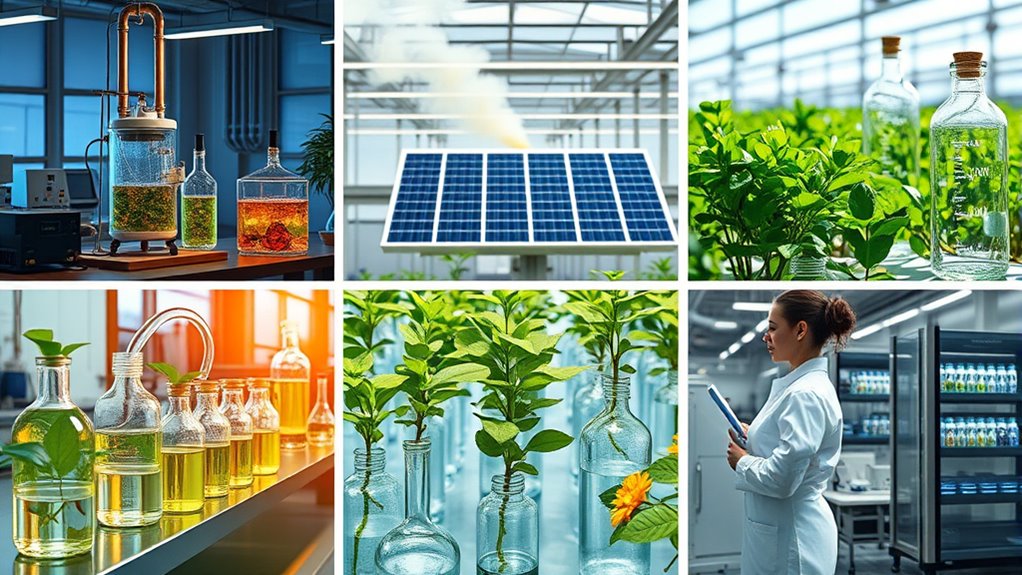
Advancements in green chemistry are shaping the future of sustainable industry practices, propelled by cutting-edge technologies like artificial intelligence (AI) and machine learning (ML). These tools accelerate the discovery of eco-friendly processes by integrating materials science and biotechnology, making innovations faster and more efficient. Breakthrough technologies in 2024 are expected to further enhance green chemistry applications across industries. You’ll see increased demand for bio-based specialty chemicals, which help reduce environmental impacts and improve product lifecycles. Industry 4.0 applications, including automation and advanced manufacturing, are streamlining green chemistry adoption. Circular economy initiatives are emphasizing sustainable product cycles, minimizing waste. Cross-industry partnerships are crucial for fostering innovation in emerging green markets.
Frequently Asked Questions
How Do Green Chemistry Principles Influence Regulatory Policies?
You see that green chemistry principles directly shape regulatory policies by promoting safer, more sustainable processes. They encourage regulations that prevent waste, improve safety, and reduce environmental harm.
These principles inspire policies with incentives, strict guidelines, and international cooperation, all aimed at fostering innovation and market growth. As a result, you’re more likely to see policies that support safer chemicals, cleaner production, and long-term environmental protection.
What Challenges Hinder Widespread Adoption of Green Chemistry Technologies?
So, you’re wondering why green chemistry isn’t taking over the world faster? Well, you’ll find high startup costs, uncertain ROI, and tricky regulations standing in your way.
Traditional chemicals still beat green options on price and performance, and bureaucratic red tape makes approvals a nightmare.
Plus, inconsistent incentives and lack of trust make it tougher to convince everyone to switch.
It’s a classic case of progress running into old-school resistance.
How Do Green Processes Compare Economically to Traditional Methods?
You’ll find that green processes often save money over traditional methods by reducing raw material use, energy consumption, and waste disposal costs. Although initial investments can be higher, they pay off long-term through improved efficiency, lower liability, and market appeal.
Plus, greener practices align with regulations and consumer demand, helping you stay competitive and sustainable while cutting operational expenses and boosting profitability over time.
What Education Is Necessary to Promote Green Chemistry Practices?
Thinking of green chemistry education as planting seeds for a sustainable future, you need a solid foundation. You should pursue at least a bachelor’s degree in chemistry or related fields, emphasizing organic chemistry and biochemistry.
Certifications like those from the ACS boost your credibility. Hands-on lab experience and courses in sustainability, safety, and systems thinking are essential, preparing you to create innovative, environmentally responsible chemical solutions.
How Can Consumers Support Green Chemistry Initiatives?
You can support green chemistry initiatives by choosing eco-friendly products with clear labeling, which shows your commitment to safer, sustainable options. Your demand influences companies to adopt greener practices, especially when you prioritize brands known for sustainability.
Participating in community activities, providing feedback, and advocating for supportive policies also make a difference.
Conclusion
As you explore these innovative green chemistry examples, you’ll see how industry leaders are transforming processes for a cleaner future. But the real question is, what groundbreaking advancements lie just beyond the horizon? With ongoing research and increasing adoption, the next chapter in sustainable chemistry promises surprises that could redefine how we produce and protect our planet. Stay tuned—what’s coming might just change everything you thought you knew.

